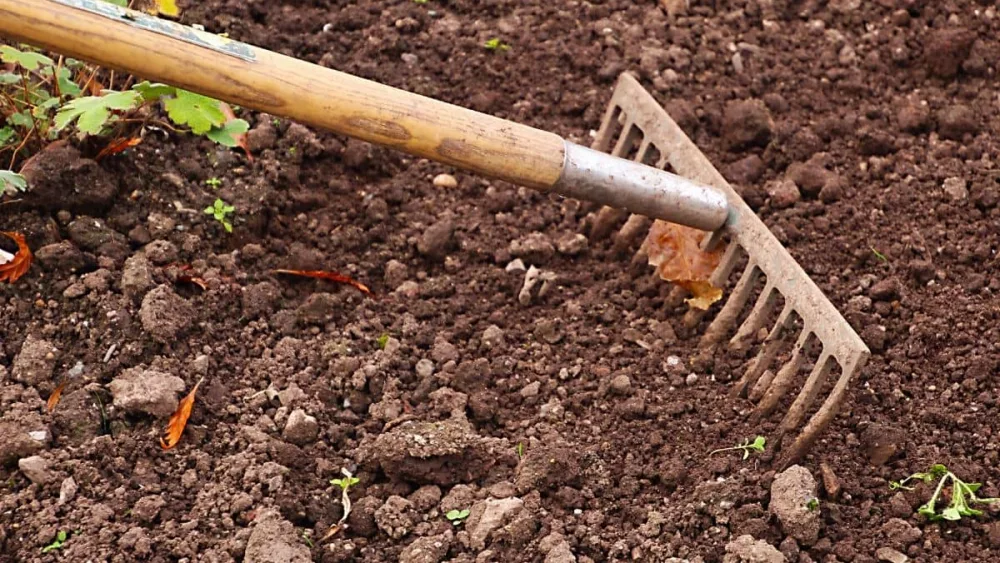Clay soils, found in many of our landscapes, do not mean you can never achieve a garden worthy of glossy magazine coverage but it does mean you will have to work harder at it. Improving your clay soil starts with a basic working knowledge of soil structure and plant needs.
First, consider that most plants’ roots grow in the top 8 to 10 inches of soil; even big trees have most of their roots in the upper 18 inches. Underground, roots still need oxygen to “breath” and water to “drink”. Air and water are found in the pore spaces of soils. A good soil is made up of 50% minerals and organic matter and 50% pore space. But a heavy clay soil has considerably less pore space which restricts both air and water. When clay soil is compacted during home construction or just heavy foot traffic, pore space is reduced even more. During rain, what pore space remains fills with water and pushes out the oxygen. If the soil drains slowly (and most clay soils do) your plants start to suffer from lack of air to the roots.
We can increase pore space, loosen compaction, add nutrients, and improve drainage to clay soils by adding organic amendments. Before planting in the spring apply a 2-to-3-inch layer of compost or aged manure to the surface of a garden or plant bed and work it into the soil 6 to 8 inches deep. Established beds can be amended with annual topdressing of compost or mulch. It is a bit more difficult to amend soil in an existing lawn without starting over, but you can try using a core aerifier which pulls out plugs of soil. Then top-dress with compost, raking it down into the holes you created. Over a period of years, you can start to change the organic matter level without destroying your lawn.

Suitable compost is made from any plant-derived material. You can make your own from yard waste, leaves, grass clippings, vegetable peelings, and other items that have well decomposed, or you can buy compost. The rule of thumb should be, if you can tell what the individual pieces used to be, it’s still too fresh to be used as a soil amendment, but it could be used as mulch. Pine bark mulch is finely ground pine nuggets sold commercially and is also a good amendment. Composted manure is also an excellent amendment and is readily available in our area. It is ready for use if it does not have a “barnyard smell”. Avoid products called “soil conditioner” as many are too fine to provide needed pore space. Peat moss, sand, fresh wood chips, sawdust, and fresh manure are also not recommended soil amendments.
Adding organic matter to the soil means the entire area or at least the entire flower bed or garden spot. Adding organic matter to the planting hole alone is not a good way to improve poorly draining clay soils. A planting hole in hard clay is essentially a bathtub with no drain. You may have replaced the bad soil with good, but the water still has nowhere to go. It is better to work the amendments into a larger area of the soil. In the case of planting trees, if you are not going to till up an area 3 to 5 times the diameter of the rootball when adding amendments, it’s best to use the same soil you took out of the hole to fill back up the hole.
If amending the soil sounds too complicated, you could always build raised beds and fill them with compost or a compost/topsoil blend. Raised beds are extremely popular for vegetable gardens and are very successful.
Finally, there are many perennials, shrubs, and trees that although they do great in amended soils still do fine in clay soils. Success of these plants will vary based on the amount of compaction and flooding a site might receive but they are still worthy of consideration and attractive in the landscape as well.
What follows is a shortlist of recommended plants for clay sites, but a full list of plants can be requested from the Christian County Extension office by calling 270-886-6328.
Trees: Hedge Maple; Red Maple; Amur Maple; River Birch; Hackberry; Eastern Redbud; Ginkgo; Sweetgum; Sweetbay Magnolia; Swamp White Oak; Baldcypress
Shrubs: Barberry; Cotoneasters; Spirea; Deutzia; Sumac; Clethra
Perennials: Coreopsis; Dianthus; Black-eyed-Susan; Mealycup Sage; Ostrich Fern; Little Bluestem; Feather Reed Grass; Switch Grass
Don’t miss the Christian County Master Gardener EXPO on Location, Saturday, April 17 from 9am to 1pm. We are taking the EXPO on the road this year to some of our regular vendors including The Bloomery, Superlawn and Garden, Christian County FFA Greenhouse, the Country Barn, Free Range Flowers, Homestead Greenhouse, Hosta Haven, Maple Shade Greenhouse, Woodcorner Greenhouse, and the Downtown Hopkinsville Farmers Market.
This is a self-guided tour with lots of giveaways, special events, on-site tours, fun for the whole family. We know you are itching to get gardening so let us introduce you to some of these great locations. Pick up a free “ticket” at any participating location and visit at least 3 vendors to be entered for the giveaways. Free tool sharpening provided by Arrowhead Fix-it at the Farmers Market location.
— Kelly Jackson, Christian County Extension Agent






